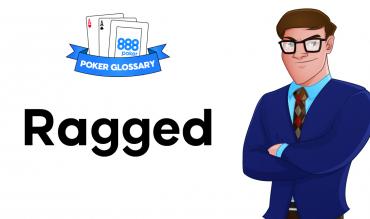Explanation of Ragged
In Hold’em and Omaha players use the following expressions to describe different types of board textures.
Rainbow – Indicates that every card on the flop is of a different suit.
(Can also be used to describe the turn.)
Two-tone – Indicates that two of the cards on the flop are of the same suit.
(Can also be used to describe the turn.)
Monotone – Indicates that all of the cards on the flop are of the same suit.
(Can also be used to describe the turn.)
Ragged – Opposite of “connected”. Implies there is little to no co-ordination between the cards on the board. “Rag” is also the term in poker used to describe a low uncoordinated card.
Dry – Similar to ragged. Indicates that there is little in the way of flush or straight connectivity.
Drawy – Indicates that there are a number of possible straight draws of flush draws available on the board.
Paired – Indicates that there is a pair on the board
How to Use Ragged as Part of Your Poker Strategy
Ragged implies three mid-to-low ranked cards with little or no connection between them, for example a 942 rainbow texture. The most common examples of “ragged” boards are those with a high-card; A72r, K84r etc although the high card itself is not considered a rag.
Rainbow ragged boards with no high-cards are often considered dry boards, but this can be misleading since any hand with overcards actually has a “draw” to make top pair. Boards such as the 842 rainbow hence routinely generate more action than many players might expect.
Low ragged boards occur infrequently since the most common board textures are those with at least one high-card, Ace-high boards being the most common.
Paired boards are often described as “ragged” due to the lack of co-ordination. 822 rainbow might be described as “ragged” for example.
Note that ragged could also be used to described starting hands lacking co-ordination in both Hold’em and Omaha.
See Also


